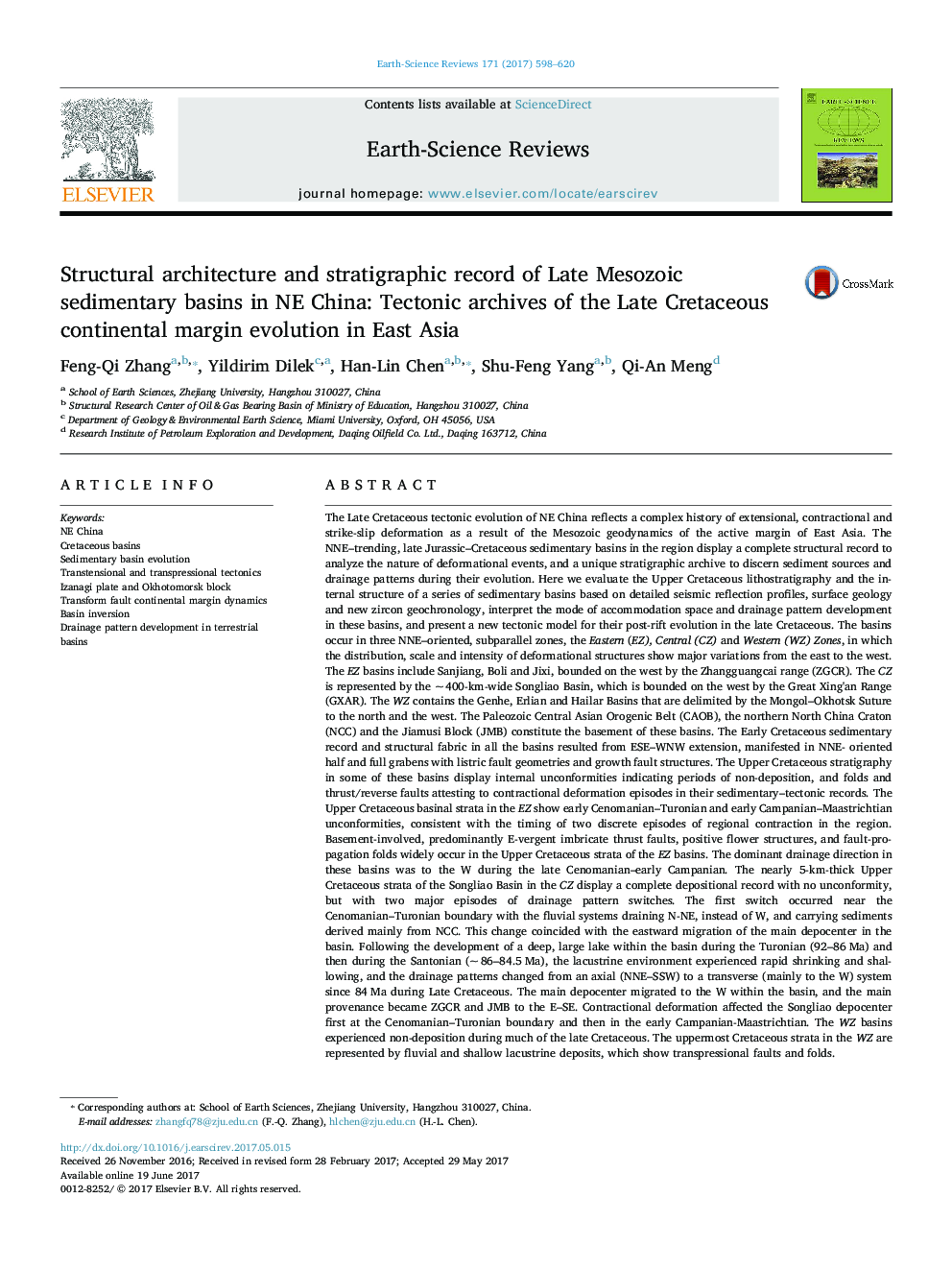| کد مقاله | کد نشریه | سال انتشار | مقاله انگلیسی | نسخه تمام متن |
|---|---|---|---|---|
| 5785102 | 1639931 | 2017 | 23 صفحه PDF | دانلود رایگان |

The Late Cretaceous tectonic evolution of NE China reflects a complex history of extensional, contractional and strike-slip deformation as a result of the Mesozoic geodynamics of the active margin of East Asia. The NNE-trending, late Jurassic-Cretaceous sedimentary basins in the region display a complete structural record to analyze the nature of deformational events, and a unique stratigraphic archive to discern sediment sources and drainage patterns during their evolution. Here we evaluate the Upper Cretaceous lithostratigraphy and the internal structure of a series of sedimentary basins based on detailed seismic reflection profiles, surface geology and new zircon geochronology, interpret the mode of accommodation space and drainage pattern development in these basins, and present a new tectonic model for their post-rift evolution in the late Cretaceous. The basins occur in three NNE-oriented, subparallel zones, the Eastern (EZ), Central (CZ) and Western (WZ) Zones, in which the distribution, scale and intensity of deformational structures show major variations from the east to the west. The EZ basins include Sanjiang, Boli and Jixi, bounded on the west by the Zhangguangcai range (ZGCR). The CZ is represented by the ~Â 400-km-wide Songliao Basin, which is bounded on the west by the Great Xing'an Range (GXAR). The WZ contains the Genhe, Erlian and Hailar Basins that are delimited by the Mongol-Okhotsk Suture to the north and the west. The Paleozoic Central Asian Orogenic Belt (CAOB), the northern North China Craton (NCC) and the Jiamusi Block (JMB) constitute the basement of these basins. The Early Cretaceous sedimentary record and structural fabric in all the basins resulted from ESE-WNW extension, manifested in NNE- oriented half and full grabens with listric fault geometries and growth fault structures. The Upper Cretaceous stratigraphy in some of these basins display internal unconformities indicating periods of non-deposition, and folds and thrust/reverse faults attesting to contractional deformation episodes in their sedimentary-tectonic records. The Upper Cretaceous basinal strata in the EZ show early Cenomanian-Turonian and early Campanian-Maastrichtian unconformities, consistent with the timing of two discrete episodes of regional contraction in the region. Basement-involved, predominantly E-vergent imbricate thrust faults, positive flower structures, and fault-propagation folds widely occur in the Upper Cretaceous strata of the EZ basins. The dominant drainage direction in these basins was to the W during the late Cenomanian-early Campanian. The nearly 5-km-thick Upper Cretaceous strata of the Songliao Basin in the CZ display a complete depositional record with no unconformity, but with two major episodes of drainage pattern switches. The first switch occurred near the Cenomanian-Turonian boundary with the fluvial systems draining N-NE, instead of W, and carrying sediments derived mainly from NCC. This change coincided with the eastward migration of the main depocenter in the basin. Following the development of a deep, large lake within the basin during the Turonian (92-86Â Ma) and then during the Santonian (~Â 86-84.5Â Ma), the lacustrine environment experienced rapid shrinking and shallowing, and the drainage patterns changed from an axial (NNE-SSW) to a transverse (mainly to the W) system since 84Â Ma during Late Cretaceous. The main depocenter migrated to the W within the basin, and the main provenance became ZGCR and JMB to the E-SE. Contractional deformation affected the Songliao depocenter first at the Cenomanian-Turonian boundary and then in the early Campanian-Maastrichtian. The WZ basins experienced non-deposition during much of the late Cretaceous. The uppermost Cretaceous strata in the WZ are represented by fluvial and shallow lacustrine deposits, which show transpressional faults and folds.We infer that the post-rift development of the sedimentary basins and hence the crustal evolution of NE China in the late Cretaceous were mainly controlled by the continental margin tectonics and plate interactions between the Okhotomorsk block (OB), part of the Izanagi oceanic realm, and East Asia. The initial arrival of OB at the East Asia Trench around 100-89Â Ma caused the first episode of contractional deformation across the sedimentary basins, and resulted in major shifts in their drainage patterns. The NE translation of OB along the sinistral transform plate boundary during 84-77Â Ma exerted a transpressional stress regime, which produced positive flower structures and thrust faults across the basins. The final collision of OB with Siberia-Sakhalin to the north ~Â 70-65Â Ma resulted in further shortening and inversion within the CZ-WZ basins, and in reactivation of previously formed normal faults as thrust faults.
Journal: Earth-Science Reviews - Volume 171, August 2017, Pages 598-620